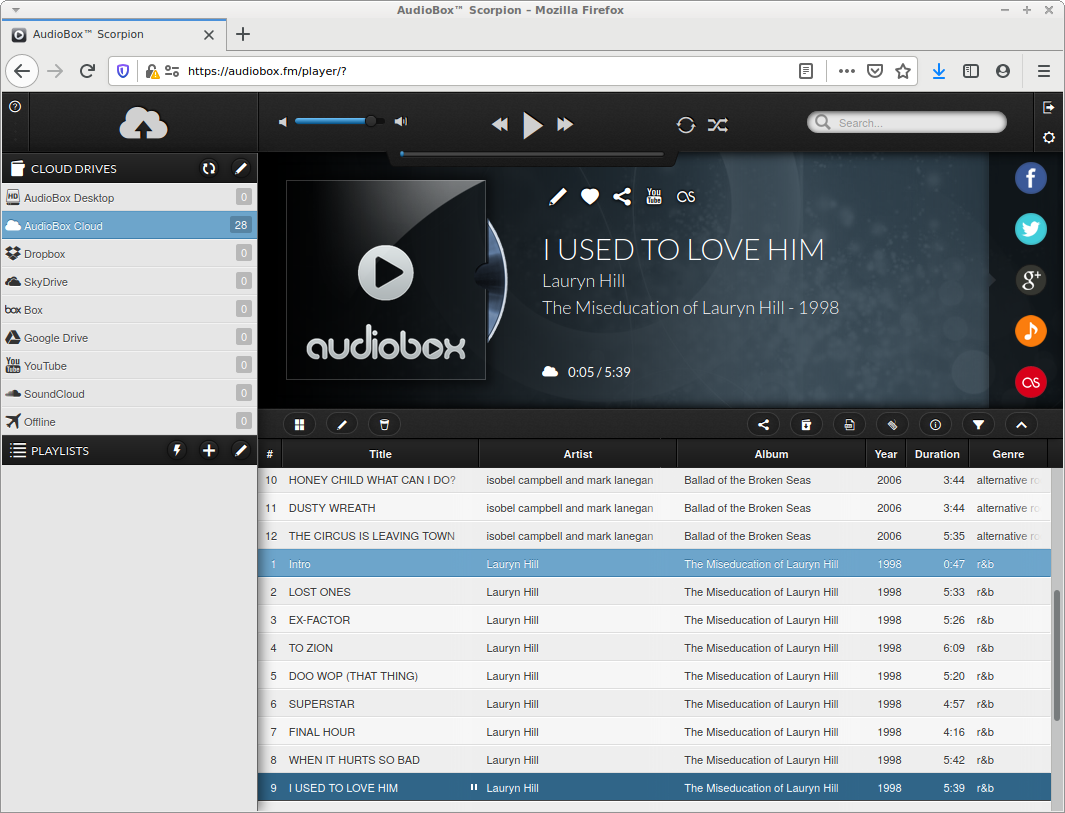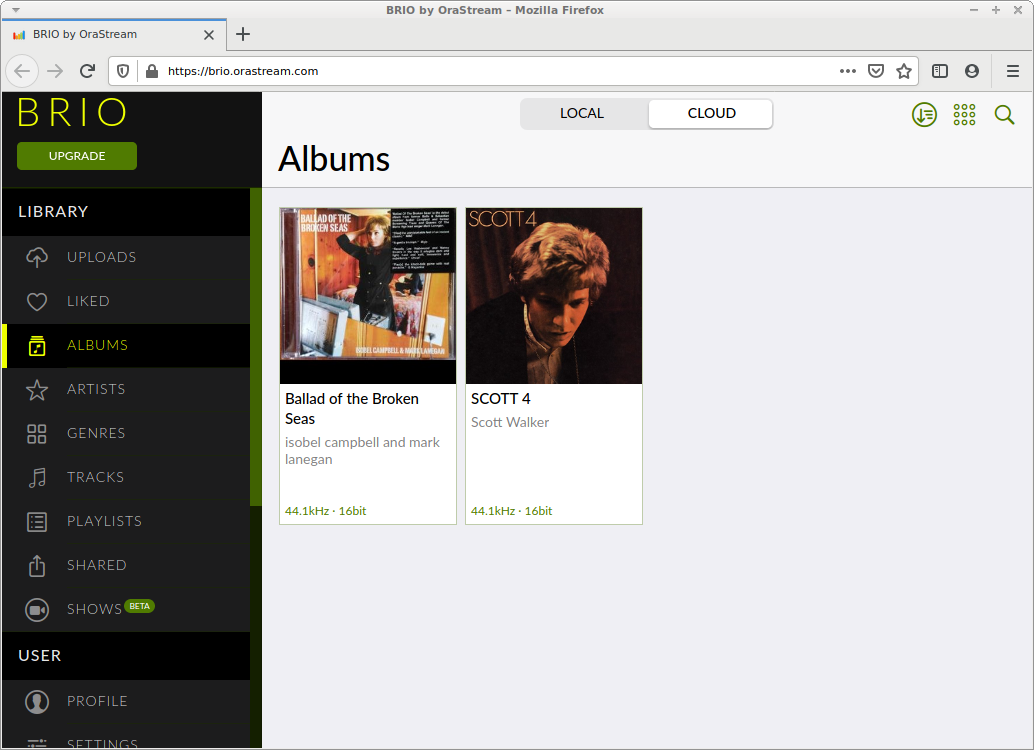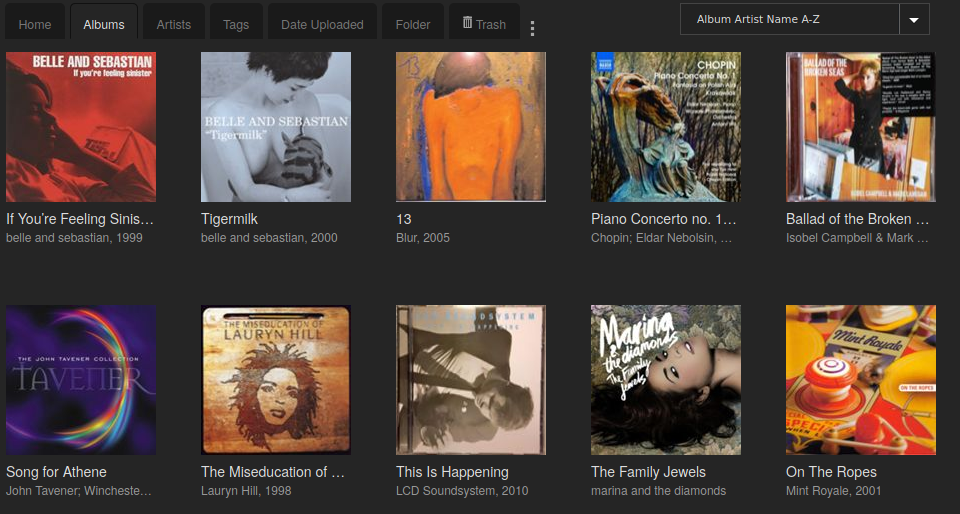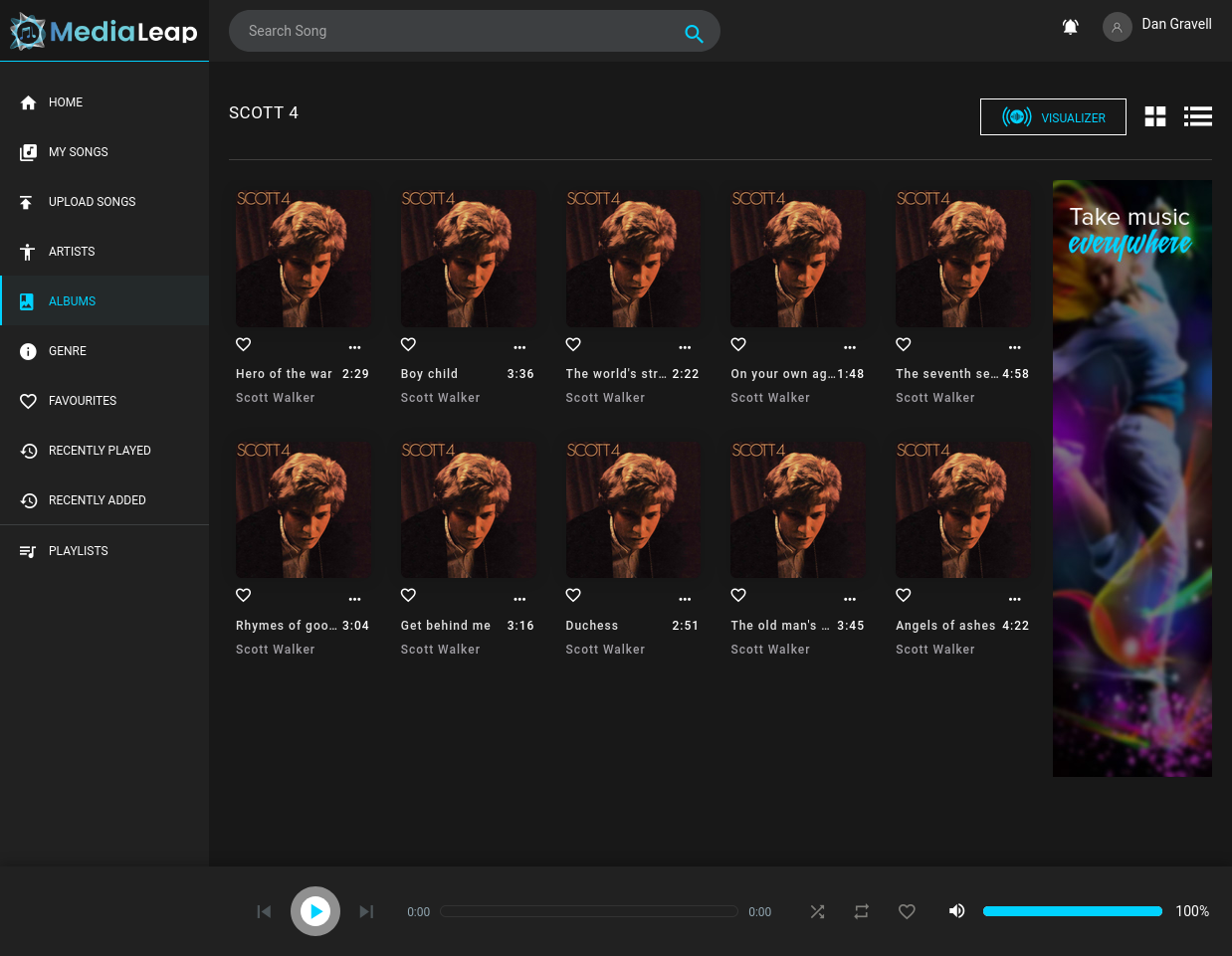Cloud music lockers
January 06, 2021 in digital music by Dan Gravell

Three months ago I surveyed the best cloud storage services for music. Those were generic storage services what you can use to store anything, although I focused on their applicability to music.
This time I’m focusing on music specific services. That means: online services that are geared toward music and allow upload of an existing music library. Sometimes they are called cloud music lockers.
More specifically still, I’m going to be concentrating on the suitability of these services to serve as the one-true location for your music library. That is, can you upload a music library and trust it will remain true to its original fidelity, both in terms of audio, and the library organisation? Can you edit the library and re-download it for potential upload elsewhere?
That might be ambitious. There are advantages to be had from one of these services simply being a secondary location for your music. For example, it makes remote playback of your library simpler.
As before, I’m going to try to summarise these in a table and highlight what I think are the best services for different use cases.
Online music libraries
A series of blog posts exploring online music library management.
The fundamentals
As with the generic storage services, I’m going to lay out some ground rules of what we’re trying to do. We’re aiming to use these services as, potentially, the ‘gold source’ for our music libraries, thus we want few restrictions on what we can upload.
- The service should take care of storage for you. Other services that allow you to bring your own storage are available, but aren’t covered here.
- We’ll need to be able to upload at least 5,000 albums, and ideally there should be no limit.
- We should be able to upload all music file formats.
- We should be able to upload and download our library.
Let’s take a look at the services!
Apple iCloud Music Library
The backend music storage service offered by Apple is called the iCloud Music Library. If you’ve not heard of it, that’s because it’s fronted by consumer services. It’s the same storage service used by both iTunes Match and Apple Music. Those two services work for different use cases; iTunes Match is an online locker for those that prefer to use self hosted iTunes, and Apple Music is a streaming service.
When you upload your library, your music is either ‘matched’ (by fingerprinting) or, if it can’t be matched, it’s uploaded.
Apple iCloud Music Library is not a good solution for audiophiles. If a file is matched, you can only ever stream the music back as a 256KB bit-rate AAC file. If you upload, any high quality WAV, ALAC or AIFF files are transcoded to AAC.
For those that aren’t audiophiles, Apple iCloud Music Library could still be a convenient solution as a secondary playback source. For example, it makes listening to your library remotely much easier, as your Apple devices can easily access the music you have uploaded.
The price of using iCloud Music Library via iTunes Match alone is very reasonable and cheaper than most alternatives. Therefore, it might make sense for an all-in Apple diehard that isn’t too bothered about audio fidelity.
AudioBox
AudioBox takes a federated approach - it seeks to unify the music you have uploaded to other cloud storage services with those you have uploaded to their own cloud.
You can upload FLACs and other lossless files, although not high res DSFs. Interestingly, the FAQ suggests converting files to MP3 before uploaded so that subsequent streaming is more performant. This is understandable, but not consistent with the goals of a remote music library organisation service.
Once uploaded, files can be accessed via the Web player. This is split into sections by source - the AudioBox Cloud is only one source; the others being the aforementioned federated cloud storage services, such as Dropbox, Google Drive et al.
AudioBox's tracks list for files inside the AudioBox Cloud
Unfortunately the music library display is not to my liking - it’s basically just a spreadsheet dump of songs with no option to browse by artist, year or genre. There is the opportunity to edit the library by changing metadata, but subsequently downloading these files still returned the original uploaded music without the changes. In addition, embedded cover art didn’t seem to be supported.
Finally, FLACs couldn’t be played back via the Web player - the FAQs talk about having to support HTML5 audio, but FLAC is supported in my browser, so I’m not sure why this didn’t work.
Overall, AudioBox is promising, but the interface is not sufficiently library-oriented right now. Also, not being able to play FLAC seems quite a fundamental issue.
BRIO
BRIO is a music locker by OraStream. BRIO really concentrates on playback, and dials that up a notch by concentrating on audiophile playback.
Many audiophiles have become familiar with music servers. They are computers, typically in the home, that your playback hardware connects to and streams music from. BRIO is a hybrid between cloud based streaming and a home-based music server. One of the main reasons for keeping music servers in your home was to benefit from the far higher bandwidth in a LAN, enabling higher fidelity music. In BRIO’s case, though, they’ve developed a way of storing your music in the cloud at native resolution, then streaming that to playback hardware in your home via an app running on your computer, using what they call adaptive streaming. That’s a boon for devices over less reliable networks, e.g. mobile devices in areas of your home with spotty connections.
To get the full value of BRIO playback, you need a Mac or Windows computer. I found, however, that I could use a Web browser in Linux to upload music and play it back via the Web browser.
BRIO's album list
Unfortunately the music library management feature set is limited. Albums or tracks cannot have their names changed, album art cannot be changed, and more. There is a higher tier plan aimed at record labels or artists which allow shareable player widgets to be customised with different track names, but this would available to the lower tiers and, besides, doesn’t sound like it covers what I’d really want in terms of library management.
Happily, the major lossless formats are supported. BRIO looks polished and does seem to offer excellent sound quality… I hope in the future they can develop the library management capabilities of the service.
Deezer
Deezer do offer a music locker service, however it’s so limited it cannot be recommended for this article.
You can only upload 2000 MP3s, and it’s MP3s only. It’s only useful as a remote playback convenience.
iBroadcast
iBroadcast takes more of a library-centric approach. They specifically call-out that they are not a streaming service offering an existing library, and you can only access the music you upload.
A good range of file formats are supported, including WAV and FLAC. You can either upload via the web uploader, or, given upload is often quite a long-winded affair, special software to sync the library. The uploader runs on Windows, Mac and Linux (although the Linux version must be compiled).
iBroadcast's album list
Good news and bad news for library maintainers: you can update tags and this affects how music is shown in the service. However, downloading the music retains the original tags. So if you want full flexibility and to be able to transfer your music, currently iBroadcast doesn’t work for full library maintenance. However, downloading with updates is planned
iBroadcast recently (updated 19th April 2022) came out of beta and offer two levels of service - Free and Premium. The Free tier enforces lower bit rate streaming at 128kbps, may become throttled and has a lower priority of customer support. Premium is $3.99/month and allows streaming at any bit rate, including the original uploaded quality. Both tiers allow unlimited uploads.
Surprisingly, the Free service is, well, free. I fail to understand how they can support this, and yet it is promised forever. This makes me hesitant to recommend the service because ‘forever’ is a hell of a debt to take on. For music library management, we generally want a service we can be assured will stay around for a while, because moving the library will be time-expensive. In the comparison table I’ve given the price for Free, because that’s all that’s required for the music library management use case.
Media Leap
Media Leap was launched at the end of 2020. Like iBroadcast it only offers a library management service for your existing music. You can stream from the service - but you’re only streaming your own files.
FLAC is supported, as are MP3 and OGG, but when I tried uploading an MP4 file it refused the upload. This is surprising; MP4 is pretty popular. I also tried AIFF and that was refused too. Strangely, it allowed a DSF upload to begin, but it never appeared to complete.
Pricing seems ultra competitive again - almost too competitive. A huge free tier of 1TB of files will probably be enough for a lot of people to store their entire collection without paying. Again, this doesn’t sound sustainable but maybe I don’t understand something of the economics.
One of the nice things about Media Leap is that you don’t need to use the mobile apps. You can log in and upload using the Web. At the time of writing you can only multi select files to upload, which is a pain for a hierarchical music folder. Also, downloading of files is one-at-a-time - there’s no bulk download.
Media Leap's track list for an album
Once uploaded there are some good library maintenance features. Files can be tagged with new information, and when re-downloaded the file contains the updated tags. However, like the download functionality, this can only be done one song at a time. There’s a chance to “Edit Album” but album wide information like the release year doesn’t appear to be copied to the individual tracks.
Overall… this is so close! With a few small tweaks to library management, and the ability to bulk sync, this would achieve the base functionality I’d expect from an online music library management solution.
Vox Best for Apple-only remote playback
Vox is quite closed, technically, and targeted at the Apple-using market. Nevertheless, it’s a slick looking service which ticks the boxes for many people.
The service is targeted at audiophile quality mobile playback of your music library rather than music library management. It’s Apple biased, being only accessible via its Apple-only apps, although it supports Sonos playback too. There’s no Web client.
Much of the benefits of Vox depend on the Vox player. The Vox player offers an awful lot, and the big news for music collectors is that it supports multiple formats (including FLAC).
However, it’s just about the playback. There’s no way to re-organise your music, nor re-export your uploaded music. It’s no solution for music library management.
Storage is unlimited, but one possible fly-in-the-ointment is the individual file limit is just 250MB. I’ve seen a number of FLAC files larger than this, particularly longer classical tracks, and as you get into high-res music this limit could easily be breached.
Because it executes well for its target market, I’ve awarded this service the best service for Apple-only users that are satisfied with remote playback only.
YouTube Music
YouTube Music allows music to be uploaded. It superceded Google Play Music, to the consternation of many. Last year I wrote up ways of exporting your music library and re-organising the semi-mess that is provided.
YouTube Music's uploaded album list
YTM is another service which is really just a glorified secondary home for your music; it’s oriented around the remote playback use case. You can’t edit or organise the music you upload. File format support is pretty good though, allowing FLACs to be uploaded.
Both paying and free users have the same maximum file limit - 100,000 tracks. If you pay, you get more features rather than more space - stuff like casting your uploaded music, avoiding adverts and offline playback.
Bring-your-own storage
There are a number of services that also allow you to connect existing storage with a music library to an app. Examples are rekordbox which allows a DJ’s rekordbox library to be synced with Dropbox and Evermusic. There’s also Plexamp which, like Evermusic, allows self hosted local storage to be used.
Our sister app, Astiga, also allows you to connect cloud storage, whether it’s Dropbox, Google Drive or others and operate that as your own streaming service. That way you get a cloud music locker with full control over your storage!
As these services don’t also organise and manage storage for you, I’ve left them out of this article. Which gives me an idea for another article…
Comparison table
For quick reference, here’s a comparison table of the services:
| Platform restrictions | Free storage | Maximum storage | Monthly subscription ($) | |
| Apple Music | None | None | 100,000 files | 2.08 |
| AudioBox | None | None | Unlimited | 0.99 (5GB) - 19.99 (200GB) |
| BRIO | None | 25GB | 1000GB | 3.33 (100GB) - 16.66 (1000GB) |
| Deezer | None | None | 2,000 files | 9.99 |
| iBroadcast | None | Unlimited | Unlimited | Free |
| MediaLeap | None | 1 TB | Unlimited | 5.00 |
| Vox | Apple devices and Sonos only | None | Unlimited | 4.99 |
| YouTube Music | None | 100,000 files | 100,000 files | 9.99 |
Summary
I was hoping to award a Best for online music library management badge, but unfortunately there’s no service that ticks the required boxes right now. iBroadcast is good, but until it allows editing of tags (and therefore music library organisation) and download of those edits, it’s not quite a full library organisation solution. MediaLeap is also close but the supported audio formats are too restrictive.
Many of the services here are aimed at solving remote playback, rather than being a home for your music library. That’s understandable; playing music is the entire point! But, for some, a cloud based music library management service would be more useful; an inevitability of having a lot of music is thinking of ways you can better browse your library, find music and then play it.
For now, it seems there are no good online music library services.
Photo by Nana Smirnova on Unsplash






